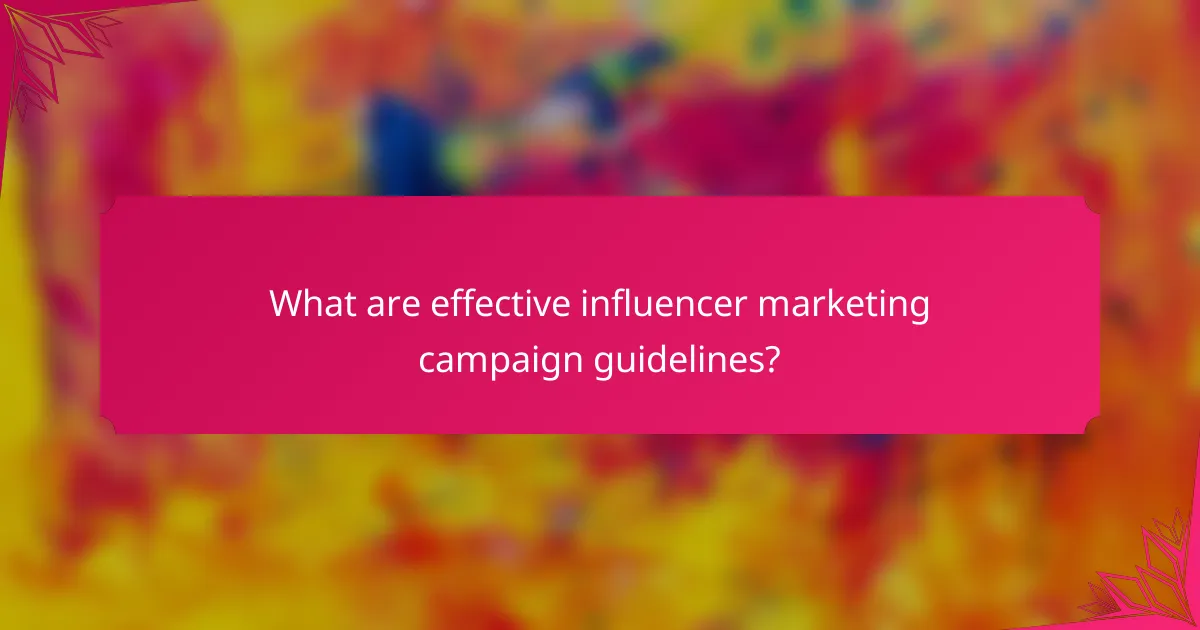Influencer marketing can significantly enhance your brand’s reach and engagement when executed effectively. Selecting the right influencers whose audience aligns with your target market is essential, while clear campaign guidelines ensure that collaborations resonate with your brand values. Additionally, tracking performance metrics such as engagement rates and ROI is crucial for evaluating the success of your campaigns.

How to select the right influencers for your campaign?
Selecting the right influencers is crucial for the success of your marketing campaign. Focus on influencers whose audience aligns with your target market, ensuring that their engagement and past performance meet your campaign goals.
Identify target audience alignment
Understanding your target audience is the first step in influencer selection. Look for influencers whose followers match your demographic criteria, such as age, gender, and interests. This alignment increases the likelihood of reaching potential customers effectively.
Utilize tools like audience analysis features on social media platforms to assess the demographics of an influencer’s followers. This data can help you gauge whether their audience is a good fit for your brand.
Evaluate influencer engagement rates
Engagement rates are a key indicator of how well an influencer connects with their audience. Look for influencers with engagement rates typically ranging from 1% to 5%, depending on their follower count and niche.
High engagement rates suggest that the influencer’s audience is actively interacting with their content, which can lead to better campaign results. Avoid influencers with low engagement, as this may indicate a less responsive audience.
Analyze past campaign performance
Reviewing an influencer’s previous campaign performance can provide insights into their effectiveness. Ask for case studies or metrics from past collaborations to understand their impact on brand awareness and sales.
Consider factors such as conversion rates, reach, and audience feedback from past campaigns. This analysis will help you determine if the influencer can deliver results for your specific goals.
Consider influencer niche relevance
The relevance of an influencer’s niche to your brand is essential for authenticity. Choose influencers who specialize in areas that align with your products or services, as this will resonate more with their audience.
For example, if you are promoting a fitness product, partnering with a health and wellness influencer will likely yield better results than collaborating with someone outside that niche. This relevance fosters trust and encourages followers to engage with your brand.

What are effective influencer marketing campaign guidelines?
Effective influencer marketing campaign guidelines provide a framework for creating successful collaborations with influencers. These guidelines help ensure that campaigns align with brand values, achieve objectives, and resonate with target audiences.
Define clear campaign objectives
Establishing clear campaign objectives is crucial for measuring success. Objectives should be specific, measurable, achievable, relevant, and time-bound (SMART), such as increasing brand awareness, driving website traffic, or boosting sales.
For example, a campaign might aim to increase social media followers by 20% within three months or generate a specific number of leads. Clear objectives guide influencer selection and content strategy.
Establish brand messaging consistency
Consistency in brand messaging across all channels is vital for building trust and recognition. Influencers should be briefed on key messages, tone, and values to ensure their content aligns with the brand’s identity.
Provide influencers with brand guidelines that include dos and don’ts, preferred hashtags, and examples of past successful content. This helps maintain a cohesive brand image while allowing influencers to express their creativity.
Set budget and compensation structures
Determining a budget and compensation structure is essential for managing costs and expectations. Budgets can vary widely based on influencer reach, engagement rates, and content type, ranging from a few hundred to several thousand dollars.
Compensation can be monetary or in-kind, such as free products or services. Clearly outline payment terms, including timelines and deliverables, to avoid misunderstandings.
Outline content creation expectations
Clearly outlining content creation expectations helps ensure that influencers deliver what is needed for the campaign. Specify the type of content required, such as videos, blog posts, or social media posts, along with deadlines and posting schedules.
Additionally, provide guidelines on content length, format, and any mandatory elements, like including specific hashtags or calls to action. This clarity helps influencers create content that meets brand standards while still being authentic to their style.

How to track influencer marketing performance?
Tracking influencer marketing performance involves measuring various metrics to evaluate the effectiveness of your campaigns. Key areas to focus on include engagement rates, return on investment (ROI), and brand sentiment.
Utilize analytics tools like Google Analytics
Google Analytics is a powerful tool for tracking website traffic generated by influencer campaigns. By setting up specific goals and tracking URLs, you can see how much traffic, conversions, and user behavior are influenced by your partnerships.
Consider using UTM parameters to tag links shared by influencers. This allows you to identify which influencer drove the most traffic and conversions, providing clear insights into their impact on your campaign.
Measure engagement metrics
Engagement metrics such as likes, shares, comments, and click-through rates are crucial for assessing the effectiveness of influencer content. A high engagement rate typically indicates that the audience resonates with the influencer’s message.
To benchmark performance, compare the engagement metrics of your influencer posts against industry averages. Aim for engagement rates that are in the mid-single digits or higher, depending on the platform used.
Assess return on investment (ROI)
Calculating ROI helps determine the financial effectiveness of your influencer marketing efforts. To calculate ROI, subtract the total cost of the campaign from the total revenue generated, then divide by the total cost and multiply by 100 to get a percentage.
A positive ROI indicates that your influencer marketing strategy is profitable. Aim for an ROI of at least 2:1, meaning for every dollar spent, you should earn two dollars back.
Monitor brand sentiment analysis
Brand sentiment analysis involves gauging public perception of your brand through social listening tools. This can help you understand how influencer partnerships are affecting your brand image.
Use tools like Brandwatch or Mention to track mentions of your brand across social media and online platforms. Look for shifts in sentiment before and after influencer campaigns to assess their impact on brand perception.

What are the prerequisites for a successful influencer marketing strategy?
A successful influencer marketing strategy requires a clear understanding of your target audience and a well-defined set of goals. Establishing these foundations allows brands to effectively select influencers, create engaging campaigns, and measure performance accurately.
Conduct market research
Market research is essential for identifying the right influencers and understanding audience preferences. Start by analyzing demographic data, social media trends, and competitor strategies to pinpoint potential influencers who resonate with your target market.
Utilize tools like surveys or social listening platforms to gather insights on consumer behavior and preferences. This information will help you select influencers whose values align with your brand and whose followers match your desired audience profile.
Develop a comprehensive marketing plan
A comprehensive marketing plan outlines your campaign objectives, target audience, and key performance indicators (KPIs). Define your goals, such as increasing brand awareness or driving sales, and tailor your influencer selection and content strategy accordingly.
Include guidelines for content creation, posting schedules, and engagement tactics. Ensure that influencers understand your brand message and campaign expectations to maintain consistency. Regularly review and adjust your plan based on performance metrics to optimize results.

How to create a decision matrix for influencer selection?
A decision matrix for influencer selection helps brands systematically evaluate potential influencers based on specific criteria. This structured approach ensures that the chosen influencers align with campaign goals and target audiences.
List criteria for evaluation
Start by defining the criteria that matter most for your campaign. Common factors include audience demographics, engagement rates, content quality, brand alignment, and past campaign performance. Each criterion should reflect your brand’s values and marketing objectives.
For example, if your target audience is primarily young adults, prioritize influencers with a strong following in that age group. Consider also the influencer’s niche relevance to ensure their content resonates with your brand message.
Score potential influencers
Once you have your criteria, assign scores to each potential influencer based on how well they meet these standards. Use a consistent scoring system, such as a scale from 1 to 5, where 1 indicates poor alignment and 5 indicates excellent fit. This quantifiable approach simplifies comparisons.
For instance, if an influencer has a high engagement rate but low brand alignment, you might score them a 4 for engagement and a 2 for alignment. Keep detailed notes on why each score was assigned to facilitate discussions later.
Rank influencers based on scores
After scoring, compile the results to create a ranked list of influencers. This ranking should reflect their overall suitability for your campaign based on the cumulative scores from your evaluation criteria. The highest-scoring influencers should be prioritized for outreach.
Consider creating a visual representation, such as a table, to easily compare scores and rankings. This method helps identify top contenders quickly and supports decision-making during the selection process.

What are emerging trends in influencer marketing?
Emerging trends in influencer marketing include a shift towards authenticity, the rise of micro and nano influencers, and increased focus on data-driven strategies. Brands are prioritizing genuine connections over follower counts, leading to more effective campaigns.
Influencer selection
When selecting influencers, brands should focus on authenticity, engagement rates, and alignment with brand values. Micro and nano influencers often have higher engagement and trust levels, making them valuable partners. Consider using tools to analyze potential influencers’ audience demographics and engagement metrics.
Campaign guidelines
Clear campaign guidelines ensure that influencers understand brand messaging and expectations. Provide a creative brief that outlines key messages, dos and don’ts, and any legal requirements, such as disclosure of paid partnerships. Flexibility in content creation can lead to more authentic and engaging posts.
Performance tracking
Tracking performance is crucial for evaluating the success of influencer campaigns. Use metrics such as engagement rates, reach, and conversion rates to assess impact. Implement tracking links and unique discount codes to measure ROI effectively. Regularly review campaign data to refine future strategies and optimize influencer partnerships.